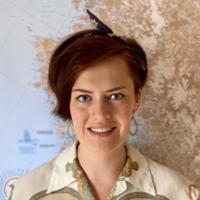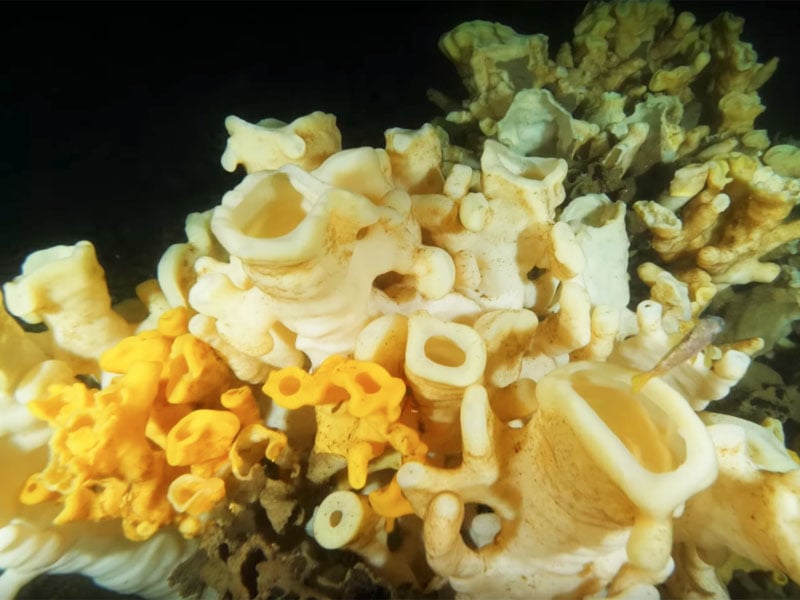A short video by environmentalist Tavish Campbell surfaced last month, and the footage illustrated a stark contrast between what looked like two previously undocumented glass sponge reefs in the Broughton Archipelago, located between mainland B.C. and the northern end of Vancouver Island.
One reef was healthy and thriving, while the other, situated beneath a salmon farm, appeared dead and smothered in waste.
The video generated great concern about the future of the sponge reef and its protection from industry such as fish farms. But there is hope that reefs like these could survive if left to heal, at least according to one researcher.
Glass sponges are animals that filter silica out of the water and use it to build their bodies. Silica is what glass is made from, and so the sponges can be thought of as effectively made of glass. The sponges use the silica to grow into beautiful and delicate patterns that form a geometric porous structure.
Glass sponges, despite their brittle structure, can develop into a plethora of fantastical shapes, sizes and colours. The healthy glass sponge reef that Campbell captured in the Broughton Archipelago was a rich, brilliant orange colour. "They look like big vases or trumpets, almost," he said.
In the murky darkness of the deep ocean, glass sponge reefs have grown as high as 20 metres, forming what look like a living city of glass at depths of up to 200 metres. But unlike skyscrapers, glass sponges don't merely reach for the surface but also expand in all directions. Scientists find glass sponges tricky to study in the wild, as they're constantly growing and changing shape.
Glass sponges filter water through intricate pores in their bodies. By doing so, they're not only feeding and building themselves but also providing an essential service to the ecosystem by filtering the ocean through their pores. The sponge gardens off the coast near Vancouver can filter all of Howe Sound in a year, according to Angela Stevenson, a biologist who has made sponges a focus of her research at the University of British Columbia.
Sediment such as that from the salmon farm will clog the sponges' pores. When the pores clog, the sponges try to "cough" and shake off those foreign particles. "But their glass skeleton is so rigid that they can't cough very well," Stevenson said.
When coughing doesn't work, the sponges switch tactics and stop drawing water into their pores. By doing so, they stop feeding, which leads to problems, Stevenson said. She believes the sponges under the salmon farm starved to death.
"It's very dubious that the farm didn't notice the sponges on the environmental survey [prior to obtaining a licence]," Stevenson said.
The damaged glass sponges were discovered under Cermaq Canada's Cecil Island salmon farm. Cermaq did not respond to a request for comment, but its managing director David Kiemele said in a previous emailed statement that the company was looking into the situation.
Sponges don't spring up overnight. Stevenson says glass sponges grow at a rate of approximately three to 10 centimetres a year. If the live sponges were two metres high, as Campbell described, they must have taken at least 20 years to reach that height. And if the sponges were truly part of a glass sponge reef, that doesn't account for the older sponge skeletons that would form the base of such a reef.
The discovery of living glass sponge reefs was a major find. Scientists knew of the existence of glass sponge gardens, which consist of ephemeral glass sponges growing on rock. Reefs are formed by sponges growing on sponges. Glass sponge reefs, before the mid-'80s, were only known from the fossil record and date back to the Jurassic Period 40 million years ago.
Glass sponge reefs have only been found in B.C. and Alaska, making them unique to this coastline.
"It's a shocker that the fish farm got the licence," said Vancouver Aquarium senior research scientist Jeff Marliave, who has been studying glass sponges for decades.
But despite some reefs being designated as marine protected areas last year, sponges are not legally listed as a protected species either provincially or federally. The sponges lying outside these areas do not receive any formal protection.
Invertebrates, or animals without a backbone, in general do not receive as much protection as their more charismatic vertebrate counterparts. B.C.'s Wildlife Act protects virtually all vertebrate animals from direct harm, save those that are allowed by hunting or trapping legislation.
The only invertebrates listed under the Species at Risk Public Registry are arthropods (which include insects, spiders and crabs) and molluscs (which include snails, bivalves and octopus). The listing process is complicated and takes time.
Glass sponge reefs, which were only discovered three decades ago, are only now being understood along with their vulnerability to human activity and what risks come from sedimentation by industry and warming ocean temperatures as a result of climate change.
Campbell says he hopes his video encourages protection for the reefs that aren't covered by the Hecate Strait marine protected area.
"I certainly hope that it spurs some sort of investigation or inquiry as to how many of these reefs are being impacted by industry," Campbell said.
Stevenson agrees. "I'm worried about other farms," she said.
The Canadian Parks and Wilderness Society described the discovery of the two reefs as a wake-up call for the government.
There is still reason to hope.
"The damage we do [to the glass sponges] is criminal," said Marliave, speaking about 50 years of trawling that utterly destroyed large stretches of glass sponge reefs in the Strait of Georgia.
But he says glass sponges are more robust than their name implies and what we give them credit for.
"Their tissues have an immortality that we don't yet understand," Marliave said.
He said some portions of glass sponges can regrow. "It's like the phoenix rising from the ashes." ![]()
Read more: Science + Tech, Environment
















Tyee Commenting Guidelines
Comments that violate guidelines risk being deleted, and violations may result in a temporary or permanent user ban. Maintain the spirit of good conversation to stay in the discussion.
*Please note The Tyee is not a forum for spreading misinformation about COVID-19, denying its existence or minimizing its risk to public health.
Do:
Do not: